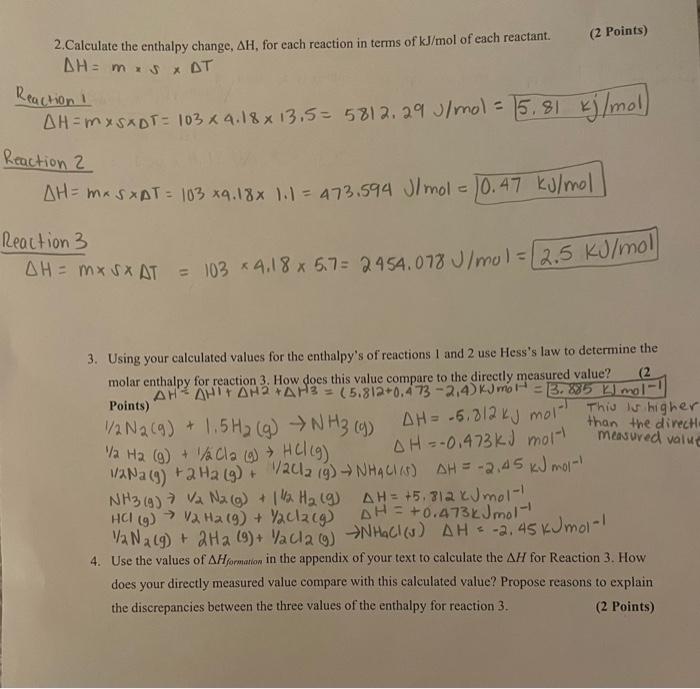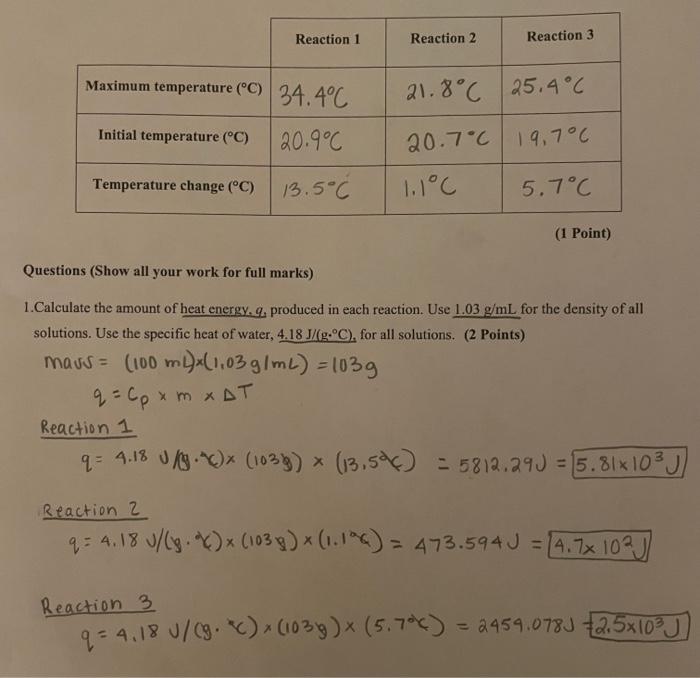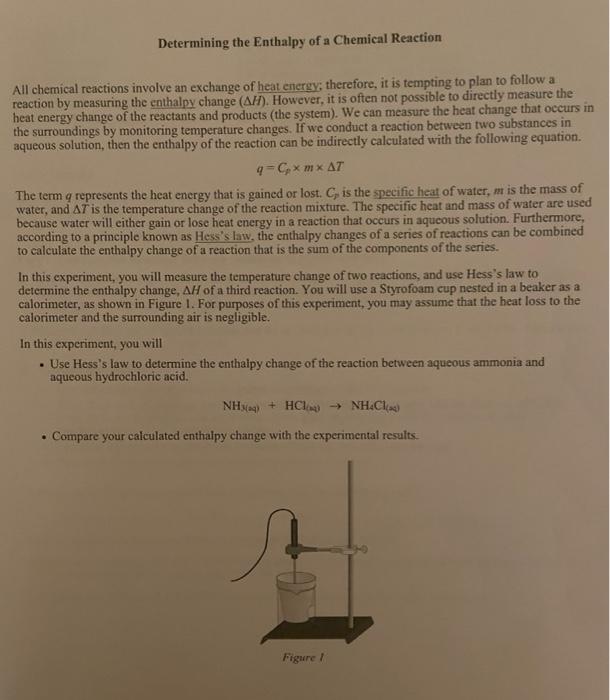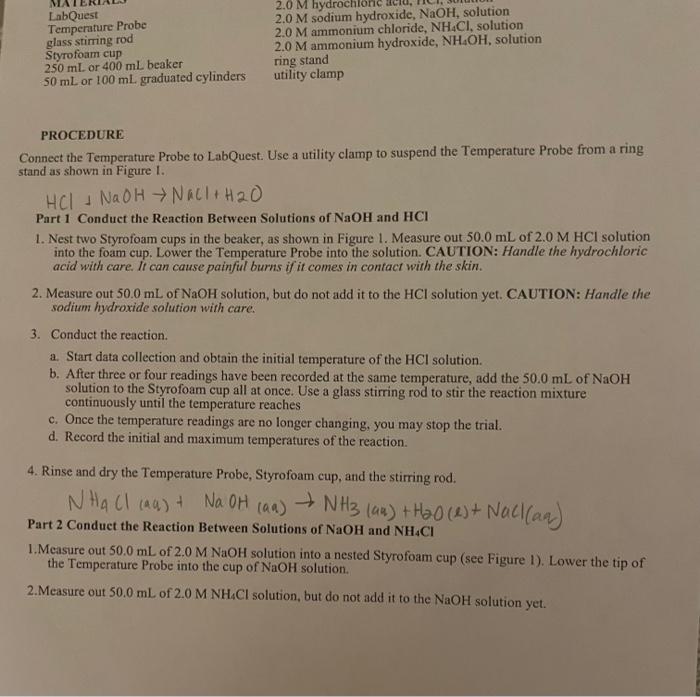Answered step by step
Verified Expert Solution
Question
1 Approved Answer
Need help with #4! (2 Points) 2. Calculate the enthalpy change, AH, for each reaction in terms of kJ/mol of each reactant. NH: mis *
Need help with #4! 



(2 Points) 2. Calculate the enthalpy change, AH, for each reaction in terms of kJ/mol of each reactant. NH: mis * AT Reaction i OH= mx SxDT= 103 x 4.18 x 13,5= 5812, 29 J/mol = 15,81 kj/mol) Reaction 2 AH = masxaT = 103 xq.18x 1.1 = 473.594 J/mol = 10.47 kJ/mol % Reaction 3 OH = MX NXAT = 103 *4.18 x 67= 2454.078 J/mol = 2.5 kJ/mol measured value + 3. Using your calculated values for the enthalpy's of reactions 1 and 2 use Hess's law to determine the molar enthalpy for reaction 3. How does this value compare to the directly measured value? (2 AH AHIRAH AH3 = (5.812+0.473 -2,4) k.) mol = 3.885 El mol-1 Points) This is higher 1/2N2 (9) + 1.5 H2 (g) NH3 (9) AH = -5,812 kJ mort than the directi Va Ha (9) + valla a) HC (9) AH =-0.473k) moll VaNa (9) +2 Ha (g) + V2ul2 (g) NHACIAS) AH = -2,45 kJ mol- NH3 (9) Va Na (g) + 14 H (9) AH = +5.812 kJ mol-1 V2 Ha (9) + Yac120g) H = +0.473Jmol-' Va N219) + 2Ha (9)+ Vacao) N Hall(s) AH = -2.45 KJ mol! 4. Use the values of AH formation in the appendix of your text to calculate the AH for Reaction 3. How does your directly measured value compare with this calculated value? Propose reasons to explain the discrepancies between the three values of the enthalpy for reaction 3. (2 Points) HCI (9) > Reaction 1 Reaction 2 Reaction 3 Maximum temperature (C) 34.4C 21.8C 25.4C Initial temperature (C) 20.9C 20.7C 19.7C Temperature change (C) 13.5C 1.1C 5.7C (1 Point) Questions (Show all your work for full marks) 1.Calculate the amount of heat energy. 4. produced in each reaction. Use 1.03 g/mL for the density of all solutions. Use the specific heat of water, 4.18 J/(g.C), for all solutions. (2 Points) maus = (100 mLx(1,03 g/mL) = 103g q = 0pxm xDT Reaction 1 q= 4.18 J/g. 6)(1039) (13.5c) - 5812.29J = = 15.81x103 X X Reaction 2 q: 4.18/19) (1039) (1.1) = 473.594 J = (4.7x 1023 Reaction 3 9-4,18 /09.)*(1039) (5.70%) = 2454.0781 42,5x10% Determining the Enthalpy of a Chemical Reaction All chemical reactions involve an exchange of heat energy, therefore, it is tempting to plan to follow a reaction by measuring the enthalpy change (AH). However, it is often not possible to directly measure the heat energy change of the reactants and products (the system). We can measure the heat change that occurs in the surroundings by monitoring temperature changes. If we conduct a reaction between two substances in aqueous solution, then the enthalpy of the reaction can be indirectly calculated with the following equation. q=mx AT The term g represents the heat energy that is gained or lost. C is the specific heat of water, mis the mass of water, and AT is the temperature change of the reaction mixture. The specific heat and mass of water are used because water will either gain or lose heat energy in a reaction that occurs in aqueous solution. Furthermore, according to a principle known as Hess's law, the enthalpy changes of a series of reactions can be combined to calculate the enthalpy change of a reaction that is the sum of the components of the series. In this experiment, you will measure the temperature change of two reactions, and use Hess's law to determine the enthalpy change, AH of a third reaction. You will use a Styrofoam cup nested in a beaker as a calorimeter, as shown in Figure 1. For purposes of this experiment, you may assume that the heat loss to the calorimeter and the surrounding air is negligible. In this experiment, you will Use Hess's law to determine the enthalpy change of the reaction between aqueous ammonia and aqueous hydrochloric acid. NHMag + HCl -> NH4Clas Compare your calculated enthalpy change with the experimental results. . Figure LabQuest Temperature Probe glass stirring rod Styrofoam cup 250 ml or 400 ml beaker 50 mL or 100 ml. graduated cylinders 2.0 M hydrochlo 2.0 M sodium hydroxide, NaOH, solution 2.0 M ammonium chloride, NH.CI, solution 2.0 M ammonium hydroxide, NHOH, solution utility clamp ring stand PROCEDURE Connect the Temperature Probe to LabQuest. Use a utility clamp to suspend the Temperature Probe from a ring stand as shown in Figure 1. HCl + NaOH NaCl + H2O Part 1 Conduct the Reaction Between Solutions of NaOH and HCI 1. Nest two Styrofoam cups in the beaker, as shown in Figure 1. Measure out 50.0 mL of 2.0 M HCl solution into the foam cup. Lower the Temperature Probe into the solution. CAUTION: Handle the hydrochloric acid with care. It can cause painful burns if it comes in contact with the skin. 2. Measure out 50.0 mL of NaOH solution, but do not add it to the HCl solution yet. CAUTION: Handle the sodium hydroxide solution with care. 3. Conduct the reaction. a. Start data collection and obtain the initial temperature of the HCl solution. b. After three or four readings have been recorded at the same temperature, add the 50.0 mL of NaOH solution to the Styrofoam cup all at once. Use a glass stirring rod to stir the reaction mixture continuously until the temperature reaches c. Once the temperature readings are no longer changing, you may stop the trial. d. Record the initial and maximum temperatures of the reaction. + NH3 (44) +H20 (est Nachlaa) 4. Rinse and dry the Temperature Probe, Styrofoam cup, and the stirring rod. NHA Cliaa) + NaOH taa) Part 2 Conduct the Reaction Between Solutions of NaOH and NHACI 1. Measure out 50.0 mL of 2.0 M NaOH solution into a nested Styrofoam cup (see Figure 1). Lower the tip of the Temperature Probe into the cup of NaOH solution. 2.Measure out 50.0 mL of 2.0 M NH Cl solution, but do not add it to the NaOH solution yet 



Step by Step Solution
There are 3 Steps involved in it
Step: 1

Get Instant Access to Expert-Tailored Solutions
See step-by-step solutions with expert insights and AI powered tools for academic success
Step: 2

Step: 3

Ace Your Homework with AI
Get the answers you need in no time with our AI-driven, step-by-step assistance
Get Started


